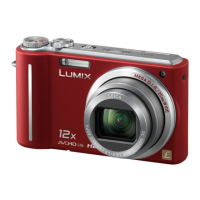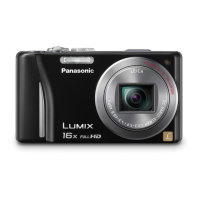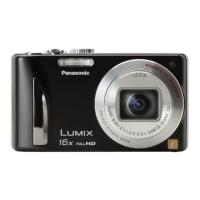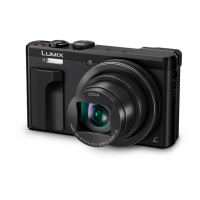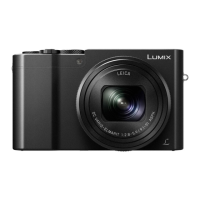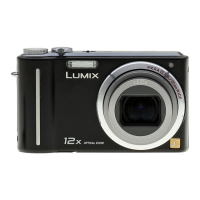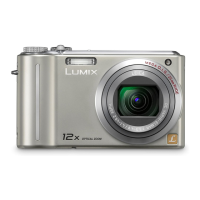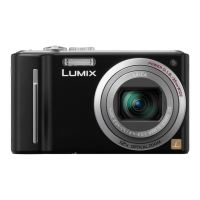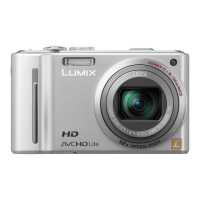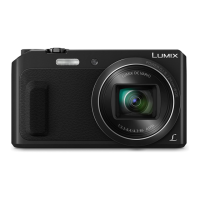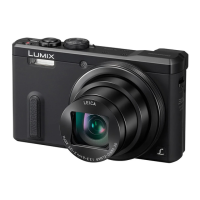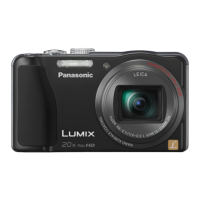
Do you have a question about the Panasonic Lumix DMC-ZS19 and is the answer not in the manual?
| Brand | Panasonic |
|---|---|
| Model | Lumix DMC-ZS19 |
| Category | Digital Camera |
| Language | English |
Safety guidelines for handling the camera and managing lens/monitor condensation.
Explains GPS features, data recording, and positioning requirements.
Identification of major external parts and their functions.
Details on LCD display elements, buttons, and cursor control.
Explains how to use touch gestures like touch and drag.
Instructions for first-time charging and battery usage advice.
Step-by-step guide for battery insertion and removal.
Guidelines for recordable pictures and operating time.
Steps for turning on the camera and selecting shooting modes.
How to take pictures with your own settings in Program AE mode.
Steps to align the AF area with the subject for accurate focus.
Using the touch screen to focus and record still pictures.
Taking pictures with automatic scene and setting adjustments.
Navigating and selecting pictures using touch or buttons.
Operating controls for playback, pause, stop, and volume.
Procedures for deleting individual or multiple pictures.
Steps to access, navigate, and set menu options.
Resetting camera to defaults and configuring USB connection.
Changing display information and using the histogram feature.
How to use the zoom lever for framing shots.
Explanation of different zoom types and their applications.
Guide to different flash modes and their uses.
Using macro mode and understanding focus distances.
Correcting exposure when subjects are too dark or bright.
Controlling aperture or shutter speed manually.
Selecting and applying various picture effects.
Choosing optimal settings for various scenes.
Steps for capturing 3D still pictures.
Saving and recalling personalized camera settings.
Choosing burst speed and parameters for continuous shooting.
How the camera recognizes faces for focus and exposure.
Recording travel dates and location information.
Setting aspect ratio and resolution for still pictures.
Selecting picture quality and adjusting ISO sensitivity.
Setting and fine-tuning white balance for accurate colors.
Choosing AF modes like Face Detection and AF Tracking.
Selecting metering modes and using intelligent exposure.
Settings for minimum shutter speed, resolution, and digital zoom.
Setting color modes and using the AF assist lamp.
Activating red-eye reduction and image stabilization.
Enabling date/time stamps and setting the camera clock.
Choosing between AVCHD and MP4 formats for video recording.
Setting resolution, bit rate, fps, and aspect ratio for videos.
Managing autofocus and suppressing wind noise.
Options for viewing individual pictures within a burst.
Choosing playback modes like Normal, Slide Show, Calendar.
Setting effects, music, duration, and repeat for slide shows.
Refining picture selection by category or favorites.
Viewing pictures by selecting a date from a calendar.
Automatically adjusting picture color and brightness.
Selecting and preparing pictures for website uploads.
Adding titles and editing GPS location information.
Factors affecting GPS signal reception and positioning accuracy.
Steps to initiate and check the status of GPS positioning.
Choosing or editing place names for recorded locations.
Modifying latitude and longitude information for pictures.
Editing location by selecting points on a map.
Editing place names from candidates or manual input.
Using the tool to download and update GPS assist data.
Steps to operate the GPS Assist Tool on the computer.
Displaying a map to confirm where a picture was taken.
Installing the map tool software on your computer.
Registering a location specified on the map as a landmark.
Selecting landmarks on map and editing/deleting them.
Steps to connect camera to TV via HDMI or AV cable.
Connecting to 3D TV and selecting 3D pictures for playback.
Methods for copying pictures to recorders or via AV cables.
Specifies compatible operating systems for PC connection.
Steps to connect the camera for transferring MP4/H.S. Video files.
Steps for preparing and uploading pictures online.
Steps to connect the camera to a PictBridge printer.
Adding date and text to prints, and printing multiple images.
Icons and information shown on the LCD in recording mode.
Icons and information shown on the LCD in playback mode.
Interpreting and resolving common card, system, and picture errors.
Troubleshooting connection and device recognition problems.
Resolving errors related to card format, motion recording, and battery.
Troubleshooting GPS issues and general recording failures.
Resolving issues with battery, power, and GPS functionality.
Resolving problems with GPS, maps, and picture recording.
Troubleshooting focus alignment, blur, and picture quality issues.
Resolving issues with motion picture recording stopping midway.
Troubleshooting panorama, AF tracking, LCD, and flash problems.
Resolving issues with viewing pictures and file display.
Troubleshooting motion picture playback on other devices.
Resolving problems connecting to TVs and computers.
Troubleshooting upload and memory card recognition issues.
Resolving printer connection and panorama printing problems.
Addressing common issues like clock errors and lens noises.
Important notes on using, caring for, and storing the camera.
Precautions for memory cards, LCD monitor, and battery.
Cautions for AC adapter, lens, tripod, and 3D viewing.
Steps to protect personal data before camera service or disposal.
Legal agreements and warnings regarding map data usage.
Information on licensed software, copyright, and data sources.
